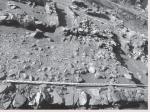Summary (English)
ST. CYRICUS ISLAND (Krastina Panaiotova – kpanayotova@abv.bg, Daniela Stoyanova, Margarit Damyanov) Room No. 1 measured 5 m by 5 m. Its southern wall laid beneath the large Archaic altar. Three pits were discovered in its southwestern part and slag, shells, charcoal, and fragmentary amphorae from Miletos, Chios, Lesbos and Klazomenai were found. There was a street, paved with uneven stones and 3.13 m wide, situated to the south of Room No. 3 that accommodated a platform paved with Corinthian tegulae. Pit No. 2, containing an arrowhead, a coin, an iron reaping hook, shells, slag and sherds of the 6th century BC, was explored in the metallurgical workshop. The residential and production quarter existed during the end of the 7th – 6th centuries BC. Two pits were discovered to the east of the Hellenistic temple, containing fragmentary Archaic Ionic pottery and Attic black-figure vessels, animal bones, shells and charcoal. A platform paved with uneven stones, 2.20 m by 1.05 m in size, was discovered in front of the southwestern corner of the Archaic temple and Pit No. 1, containing fragmentary amphorae from Miletos, Chios, Lesbos and Klazomenai, jugs, Ionic cups showing birds, two alabastra, a terracotta figurine and animal bones, was explored. Pit No. 8 was discovered in the southwestern part of the pronaos of the temple, containing fragmentary cups and amphorae from the end of the 7th to the middle of the 6th century BC, bones, slag and shells. Pit No. 3 was thoroughly explored, containing fragmentary aryballos, Ionic cups, dishes, amphorae from Miletos, Chios and Lesbos of the 6th century BC, shells. The foundation of a base for a statue was discovered in the naos of the Archaic temple. The western wall of the temple was 1.09 m wide and was preserved up to six courses, 1.32 m in height. The western wall of the large altar was preserved up to four courses of ashlars, 1.10 m in height, while the northern and the southern walls were preserved up to three courses of ashlars in height. The Hellenistic temple faced to the northeast towards the monumental altars. The circular platform, which served as a foundation for an altar, was thoroughly explored. A fragment from a Hellenistic inscription was found.
- Krastina Panaiotova - Archaeological Institute with Museum
- Daniela Stoyanova - Department of Archaeology, Sofia University St Kliment Ohridski
- Margarit Damyanov - Archaeological Institute with Museum
Director
Team
Research Body
- Archaeological Institute with Museum






![Download [PDF]](/excavation/skins/fasti/images/results/download_sml.png)

